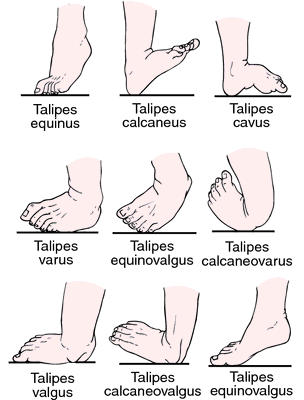talipes
[tal´ĭ-pēz]a deformity in which the foot is twisted out of normal position; see also clubfoot and see illustration. It may have an abnormally high longitudinal arch (talipes cavus) or it may be in dorsiflexion (talipes calcaneus), in plantar flexion (talipes equinus), abducted and everted (talipes valgus or flatfoot), adducted and inverted (talipes varus), or various combinations of these (talipes calcaneovalgus, talipes calcaneovarus, talipes equinovalgus, or talipes equinovarus).
There are several theories as to the cause of clubfoot. A familial tendency or arrested growth during fetal life may contribute to its development, or it may be caused by a defect in the ovum. It sometimes accompanies meningomyelocele as a result of paralysis. In mild clubfoot there are slight changes in the structure of the foot; more severe cases involve orthopedic deformities of both the foot and leg. Although clubfoot is usually congenital, an occasional case in an older child may be caused by injury or poliomyelitis.
Treatment varies according to the severity of the deformity. Milder cases may be corrected with casts that are changed periodically, the foot being manipulated into position each time the cast is changed so that it gradually assumes normal position. A specially designed splint may also be used, made of two plates attached to shoes with a crossbar between the plates and special set screws so that the angulation of the foot can be changed as necessary. More severe deformities require surgery of the tendons and bones, followed by the application of a cast to maintain proper position of the joint.
There are several theories as to the cause of clubfoot. A familial tendency or arrested growth during fetal life may contribute to its development, or it may be caused by a defect in the ovum. It sometimes accompanies meningomyelocele as a result of paralysis. In mild clubfoot there are slight changes in the structure of the foot; more severe cases involve orthopedic deformities of both the foot and leg. Although clubfoot is usually congenital, an occasional case in an older child may be caused by injury or poliomyelitis.
Treatment varies according to the severity of the deformity. Milder cases may be corrected with casts that are changed periodically, the foot being manipulated into position each time the cast is changed so that it gradually assumes normal position. A specially designed splint may also be used, made of two plates attached to shoes with a crossbar between the plates and special set screws so that the angulation of the foot can be changed as necessary. More severe deformities require surgery of the tendons and bones, followed by the application of a cast to maintain proper position of the joint.

Talipes.
Miller-Keane Encyclopedia and Dictionary of Medicine, Nursing, and Allied Health, Seventh Edition. © 2003 by Saunders, an imprint of Elsevier, Inc. All rights reserved.
val·gus
(val'gŭs), This form of the adjective is used only with masculine nouns (hallux valgus, plural halluces valgi). With feminine nouns the form valga is used (coxa valga, plural coxae valgae), and with neuter nouns the form valgum (genu valgum, plural genua valga). Do not confuse this word with varus.Latin adjective describing any joint in an extremity that is deformed such that the more distal of the two bones forming the joint deviates away from the midline, as in knock-knee.
[Mod. L. turned outward, fr. L. bow-legged]
Farlex Partner Medical Dictionary © Farlex 2012
valgus
(văl′gəs)adj.
1. Characterized by an abnormal outward turning of a bone, especially of the hip, knee, or foot.
2. Knock-kneed.
n.
A valgus bone.
val′goid′ (-goid′) adj.
The American Heritage® Medical Dictionary Copyright © 2007, 2004 by Houghton Mifflin Company. Published by Houghton Mifflin Company. All rights reserved.
valgus
Orthopedics Fixation of an extremity in the position it would assume if everted; if in the frontal plane, the plantar surface is directed away from the midline. Cf Varus.McGraw-Hill Concise Dictionary of Modern Medicine. © 2002 by The McGraw-Hill Companies, Inc.
val·gus
(val'gŭs)Descriptive of any of the paired joints of the extremities with a static angular deformity in which the bone distal to the joint deviates laterally from the longitudinal axis of the proximal bone, and from the midline of the body, when the subject is in anatomic position. The adjective valgus is attached sometimes to the name of the joint (cubitus valgus) and sometimes to the name of the part just distal to the joint (hallux valgus). The gender of the adjective matches that of the Latin noun to which it is joined; thus, cubitus, hallux, metatarsus, pes, talipes valgus; coxa, manus, talipomanus valga; genu valgum.
[Mod. L. turned outward, fr. L. bow-legged]
Medical Dictionary for the Health Professions and Nursing © Farlex 2012